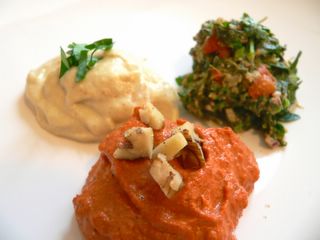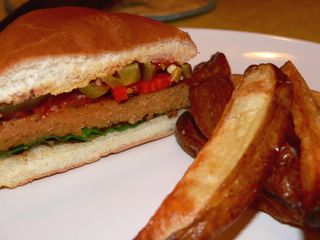the sour smell of success

thanks to a comment left by bryanna grogan i finally got a little sour success with the third incarnation of my sourdough starter mr. lucky. the first loaf i cranked out using lucky (who i visualize as the photographer on the love boat - before he showed up in married with children), though pretty-pretty, was terribly, horribly, pathetically, crushingly bland. disappointing in much in the same way i imagine it would be to meet some film star or supermodel for whom you've been secretly pining away, just to be met with shiny, marlble-like eyes and a blindingly white vacant smile that clearly shows nobody is home.
this loaf had a wonderfully springy and chewy interior with a definite note of sour-ness. not quite as sour as i like it but next time i will proof a little longer. the crust however didn't get as crispy and crackly as i'd hoped - it was a little tough and cardboard like. i attribute this to the fact that i threw in 4 1/2 cups of (king arthur) flour into the bread machine before i hit the knead button, and it quickly became apparent that this was way too much. the dough was quite dry and not tacky at all. to remedy this i kept adding water until it was passably tacky. next time i will start with 3 cups and add additional flour bit by bit. also i substituted kosher salt and added half again as much as the recipe called for - it could've used a bit more.
at the end of the day, lucky is a fine, healthy, fermentable lil' feller and i think i'll keep him. i'm now looking for other things to bake using this guy. any ideas?
Bryanna's San Francisco Sourdough Bread
the morning before baking day refresh your starter.
the night before baking day mix together in a large bowl:
2 c. warm water
1 c. fresh, bubbly sourdough starter
2 c. unbleached white flour (*canadian flour is high-gluten; in the us you may want to use unbleached white bread flour)
stir well, cover with a plastic bag, and let sit overnight in a warm place.
the morning of the baking day stir into the bubbly "sponge" or batter:
1 T. salt (do not reduce this)
about 5 c. unbleached white flour (see * note above)
knead the dough for about 10 minutes, adding 1/2 c. more flour if needed. knead by hand or with a heavy-duty mixer with a dough hook. sourdough bread dough is stickier or "tackier" than ordinary bread dough, so be careful not to add too much flour in an attempt to make it drier. if necessary, you can use a little oil on the kneading surface and your hands, rather than flour, during the last half of the kneading process. or, just use very small amounts of flour.
let rise until doubled: place the dough in the rinsed, dried, and oiled bowl, cover or place inside of a large plastic bag, and rise in a warm place until doubled, about 2-4 hours.
knuckle the dough down to gently remove air bubbles, and divide it in half equally. shape the dough into 2 round or oblong loaves and place on cooking-parchment-lined greased cookie sheets. Sprinkled the parchment with cornmeal.
cover and let rise again in a warm place for 1 to 4 hours, until doubled.
preheat oven to 400 degrees F and set a shallow pan of boiling water in the bottom of the oven. Slash the tops of the loaves with a razor blade about 1/2" deep (3 diagonal slashes on an oblong loaf; an x, square, triangle, or crisscross design on a round loaf). Brush or spray the loaves with cold water before putting the loaves in the oven.
bake the loaves for 20 minutes, brushing or spraying the loaves and the sides of the oven (cover glass oven door with a heavy towel when you do this to avoid breaking the glass) with cold water every 5 minutes during this time. this encourages good "oven spring", or rising in the oven, and a nice crust.) turn the loaves around to face the other way and reduce heat to 325 degrees F. bake about 15 minutes more for long loaves or 30 minutes more for round loaves, or until dark golden brown. the crust of sourdough bread is slightly darker and harder than ordinary french bread. remove to racks to cool for 2-3 hours before cutting as the loaves continue to cook during the cooling process.
for variations of this recipe or to see it in it's original format, click here and go to the comments page.


















